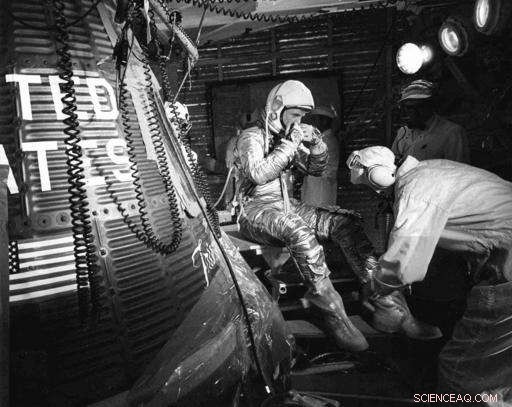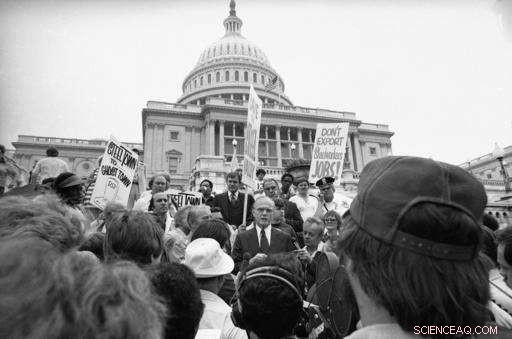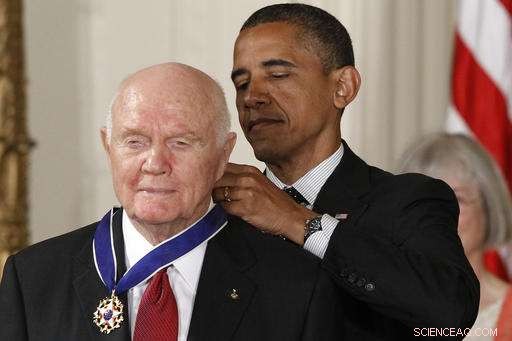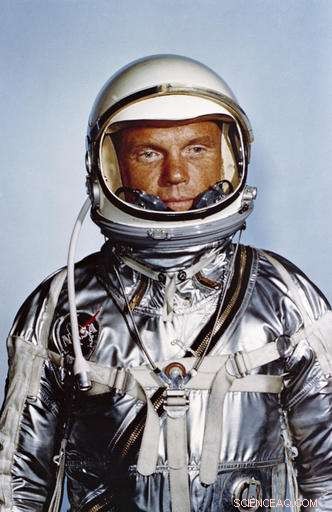
En ce 20 février, 2012, fichier photo, Le sénateur américain John Glenn s'entretient avec des astronautes sur la Station spatiale internationale par satellite avant une discussion intitulée "Apprendre du passé pour innover pour l'avenir" à Columbus, Ohio. Glenn, qui a été le premier astronaute américain à orbiter autour de la Terre et a ensuite passé 24 ans à représenter l'Ohio au Sénat, est décédé à 95 ans. (AP Photo/Jay LaPrete, Déposer)
John Glenn, dont le vol de 1962 en tant que premier astronaute américain à orbiter autour de la Terre a fait de lui un héros entièrement américain et l'a propulsé vers une longue carrière au Sénat américain, décédé jeudi. Le dernier survivant des astronautes originaux de Mercury 7 avait 95 ans.
Glenn est décédé au James Cancer Hospital de Columbus, Ohio, où il a été hospitalisé pendant plus d'une semaine, dit Hank Wilson, directeur des communications de la John Glenn School of Public Affairs.
John Herschel Glenn Jr. a eu deux grandes carrières qui se sont souvent croisées :l'aviation et la politique, et il s'envola dans les deux.
Avant de devenir célèbre en orbite autour du monde, il a été pilote de chasse pendant deux guerres, et en tant que pilote d'essai, il a établi un record de vitesse transcontinental. Il a ensuite servi 24 ans au Sénat de l'Ohio. Un revers rare a été l'échec de la course à l'investiture présidentielle démocrate en 1984.
Sa longue carrière politique lui a permis de retourner dans l'espace dans la navette Discovery à 77 ans en 1998, un tour de victoire cosmique qu'il a savouré et transformé en un moment propice à l'apprentissage du vieillissement. Il détient le record de la personne la plus âgée dans l'espace.
Plus que tout, Glenn était le héros spatial américain ultime et unique :un vétéran de combat avec un sourire facile, un mariage solide de 70 ans et des nerfs d'acier. Écoles, un centre spatial et l'aéroport de Columbus ont été nommés d'après lui. Les enfants aussi.

En ce 20 février, 1962, fichier photo, L'astronaute John Glenn est assis à côté de la capsule spatiale Friendship 7 au sommet d'une fusée Atlas à Cap Canaveral, Floride., lors des préparatifs de son vol qui fait de lui le premier Américain à orbiter autour de la Terre. Glenn, qui a ensuite passé 24 ans à représenter l'Ohio au Sénat, est décédé à 95 ans. (AP Photo/Fichier)
L'Union soviétique a fait un bond en avant dans l'exploration spatiale en mettant en orbite le satellite Spoutnik 1 en 1957, puis a lancé le premier homme dans l'espace, le cosmonaute Youri Gagarine, dans un vol orbital de 108 minutes le 12 avril, 1961. Après deux vols suborbitaux par Alan Shepard Jr. et Gus Grissom, c'était à Glenn d'être le premier Américain à orbiter autour de la Terre.
"Bon Dieu, John Glenn, " Son collègue astronaute Scott Carpenter a répondu par radio juste avant que Glenn ne tonne depuis une rampe de lancement de Cap Canaveral, maintenant un monument historique national, à un endroit où l'Amérique n'avait jamais été. Lors de ce 20 février, 1962, voyage en avion, Glenn avait 40 ans.
Avec la phrase tout-business, "Roger, l'horloge fonctionne, nous sommes en route, " Glenn a envoyé une radio à la Terre alors qu'il commençait ses 4 heures, 55 minutes et 23 secondes dans l'espace. Des années plus tard, il a expliqué qu'il avait dit cela parce qu'il n'avait pas l'impression d'avoir décollé et que c'était la seule façon dont il savait qu'il avait décollé.
Pendant le vol, Glenn prononça une phrase qu'il répéterait fréquemment tout au long de sa vie :"Zéro G, et je me sens bien."
"Cela me semble toujours aussi vivant, " Glenn a déclaré dans une interview accordée à l'Associated Press en 2012 à l'occasion du 50e anniversaire du vol. " Je peux encore en quelque sorte ressentir les mêmes sensations que j'avais à l'époque pendant le lancement et tout. "
Glenn a dit qu'on lui demandait souvent s'il avait peur, et il répondit, "Si vous parlez de peur qui surmonte ce que vous êtes censé faire, non. Vous vous êtes entraîné très dur pour ces vols."

En ce 20 février, photo de 1962 mise à disposition par la NASA, L'astronaute John Glenn pilote le vaisseau spatial Mercury « Friendship 7 » lors de son vol historique en tant que premier Américain à orbiter autour de la Terre. Glenn, qui a ensuite passé 24 ans à représenter l'Ohio au Sénat, est décédé à 95 ans. (NASA via AP)
Le trajet de Glenn dans la capsule étroite de Friendship 7 a eu ses moments effrayants, toutefois. Les capteurs ont montré que son bouclier thermique était desserré après trois orbites, et le contrôle de mission craignait qu'il ne brûle lors de la rentrée lorsque les températures atteignaient 3, 000 degrés. Mais le bouclier thermique a tenu.
Même avant, Glenn a volé dans des cieux dangereux. Il était pilote de chasse pendant la Seconde Guerre mondiale et en Corée qui volait à basse altitude, a eu son avion criblé de balles, a volé avec le grand baseball Ted Williams et a gagné des surnoms de macho au cours de 149 missions de combat. Et en tant que pilote d'essai, il a battu des records d'aviation.
Les yeux verts, telegenic Marine a même gagné 25 $, 000 sur le jeu télévisé "Name That Tune" avec un partenaire de 10 ans. Et c'était avant le 6 avril, 1959, lorsque sa vie a changé en étant sélectionné comme l'un des astronautes de Mercury 7 et a immédiatement commencé à attirer plus que sa part des projecteurs.
Glenn dans les années suivantes a régalé les foules avec des histoires de tests de la NASA sur des astronautes potentiels, des tests psychologiques - venez avec 20 réponses à la question ouverte "Je suis" - à la rotation de survie qui a poussé 16 fois la gravité normale contre son corps, éclatement des vaisseaux sanguins.
Mais ce n'était pas aussi grave que de venir à Cap Canaveral pour voir le premier test de fusée sans pilote.
"Nous regardons cette chose monter et monter et monter ... et tout à coup, elle a explosé juste au-dessus de nous, et c'était notre introduction à l'Atlas, " Glenn a déclaré en 2011. " Nous nous sommes regardés et nous voulions avoir une réunion avec les ingénieurs dans la matinée. "

En ce dimanche, 1er novembre 1998 image réalisée à partir d'une vidéo, l'astronaute John Glenn, la gauche, récupère un avion en papier pour le pilote Steven Lindsey, premier plan à droite, dans le pont intermédiaire de la navette spatiale Discovery. L'astronaute Stephen Robinson, fond à droite, et l'astronaute japonais Chiaki Mukai regardent les papiers en arrière-plan. Glenn est décédé jeudi, 8 décembre 2016, à l'âge de 95 ans. (AP Photo/NASA, Déposer)
En 1959, Glenn a écrit dans le magazine Life :« Le voyage dans l'espace est à la frontière de ma profession. Il va être accompli, et je veux y participer. Il y a aussi un élément de simple devoir impliqué. Je suis convaincu que j'ai quelque chose à donner à ce projet."
Ce sens du devoir a été inculqué dès le plus jeune âge. Glenn est né le 18 juillet 1921, à Cambridge, Ohio, et a grandi à New Concord, Ohio, avec le surnom de "Bourgeon". Il a rejoint le groupe de la ville en tant que trompettiste à l'âge de 10 ans et a accompagné son père un jour du souvenir dans une version en écho de "Taps". Dans ses mémoires de 1999, Glenn a écrit "ce sentiment résume mon enfance. Il a formé mes convictions et mon sens des responsabilités. Tout ce qui est venu après est venu naturellement."
Son amour du vol a duré toute sa vie; John Glenn Sr. a parlé des nombreuses soirées d'été où il est arrivé à la maison pour trouver son fils courant dans la cour les bras tendus, faisant semblant de piloter un avion. Juin dernier, lors d'une cérémonie renommant l'aéroport de Columbus pour lui, Glenn se souvient avoir imploré ses parents de l'emmener à cet aéroport pour regarder les avions chaque fois qu'ils traversaient la ville :"C'était quelque chose qui m'a fasciné." Il a piloté son propre avion privé jusqu'à l'âge de 90 ans.
L'objectif de Glenn de devenir pilote professionnel a été modifié par la Seconde Guerre mondiale. Il a quitté Muskingum College pour rejoindre le Naval Air Corps et peu de temps après, les marines.
Il est devenu un pilote de chasse à succès qui a effectué 59 missions dangereuses, souvent en tant que bénévole ou en tant que remplaçant demandé des pilotes affectés. A war later, in Korea, he earned the nickname "MiG-Mad Marine" (or "Old Magnet A—, " which he sometimes paraphrased as "Old Magnet Tail.")
"I was the one who went in low and got them, " Glenn said, explaining that he often landed with huge holes in the side of his aircraft because he didn't like to shoot from high altitudes.

In this Feb. 26, 1962 file photo, Mercury astronaut John Glenn, and his wife, Annie, ride in the back of an open car with Vice-President Johnson during a parade in Glenn's honor in Washington. The Capitol is seen in the background. Glenn, the first American to orbit Earth who later spent 24 years representing Ohio in the Senate, died Thursday, Dec. 8, 2016, at the age of 95. (AP Photo/File)
Glenn's public life began when he broke the transcontinental airspeed record, bursting from Los Angeles to New York City in three hours, 23 minutes and 8 seconds. With his Crusader averaging 725 mph, the 1957 flight proved the jet could endure stress when pushed to maximum speeds over long distances.
In New York, he got a hero's welcome—his first tickertape parade. He got another after his flight on Friendship 7.
That mission also introduced Glenn to politics. He addressed a joint session of Congress, and dined at the White House. He became friends with President Kennedy and ally and friend of his brother Robert. The Kennedys urged him to enter politics, and after a difficult few starts he did.
Glenn spent 24 years in the U.S. Senate, representing Ohio longer than any other senator in the state's history. He announced his impending retirement in 1997, 35 years to the day after he became the first American in orbit, en disant, "There is still no cure for the common birthday."
Glenn returned to space in a long-awaited second flight in 1998 aboard the space shuttle Discovery. He got to move around aboard the shuttle for far longer—nine days compared with just under five hours in 1962—as well as sleep and experiment with bubbles in weightlessness.
In a news conference from space, Glenn said, "To look out at this kind of creation out here and not believe in God is to me impossible."

En ce vendredi, 23 septembre 1977 file photo, Sen. John Glenn, D-Ohio, center, speaks to a group of Youngstown, Ohio Steelworkers on the steps of the Capitol in Washington. The group urged the government to curb steel imports and to relax pollution control requirements. Glenn, the first U.S. astronaut to orbit Earth who later spent 24 years representing Ohio in the Senate, died Thursday, Dec. 8, 2016, at the age of 95. (AP Photo/Harvey Georges, Déposer)
NASA tailored a series of geriatric-reaction experiments to create a scientific purpose for Glenn's mission, but there was more to it than that:a revival of the excitement of the earliest days of the space race, a public relations bonanza and the gift of a lifetime.
"America owed John Glenn a second flight, " NASA Administrator Dan Goldin said.
Glenn would later write that when he mentioned the idea of going back into space to his wife, Annie, she responded:"Over my dead body."
Glenn and his crewmates flew 3.6 million miles, compared with 75, 000 miles aboard Friendship 7.
Shortly before he ran for the 1984 Democratic presidential nomination, a new generation was introduced to astronaut Glenn with the film adaptation of Tom Wolfe's book "The Right Stuff." He was portrayed as the ultimate straight arrow amid a group of hard-partying astronauts.
Glenn said in 2011:"I don't think any of us cared for the movie 'The Right Stuff'; I know I didn't."

En ce mardi, Jan. 18, 1984 file photo, Sen. John Glenn, D-Ohio, answers questions from the press in Jackson, Miss. At left is his wife, Annie Glenn. Glenn travelled through the South seeking support for his presidential campaign. Glenn, the first U.S. astronaut to orbit Earth who later spent 24 years representing Ohio in the Senate, died Thursday, Dec. 8, 2016, at the age of 95. (AP Photo/Tannen Maury, Déposer)
Glenn was unable to capitalize on the publicity, bien que, and his poorly organized campaign was short-lived. He dropped out of the race with his campaign $2.5 million in the red—a debt that lingered even after he retired from the Senate in 1999.
He later joked that except for going into debt, humiliating his family and gaining 16 pounds, running for president was a good experience.
Glenn generally steered clear of campaigns after that, saying he didn't want to mix politics with his second space flight. He sat out the Senate race to succeed him—he was hundreds of miles above Earth on Election Day—and largely was quiet in the 2000 presidential race.
He first ran for the Senate in 1964 but left the race when he suffered a concussion after slipping in the bathroom and hitting his head on the tub.
He tried again in 1970 but was defeated in the primary by Howard Metzenbaum, who later lost the general election to Robert Taft Jr. It was the start of a complex relationship with Metzenbaum, whom he later joined in the Senate.
For the next four years, Glenn devoted his attention to business and investments that made him a multimillionaire. He had joined the board of Royal Crown Cola after the aborted 1964 campaign and was president of Royal Crown International from 1967 to 1969. In the early 1970s, he remained with Royal Crown and invested in a chain of Holiday Inns.

In this Feb. 23, 1962 file photo, astronaut John Glenn and President John F. Kennedy inspect the Friendship 7, the Mercury capsule in which Glenn became the first American to orbit the Earth. Kennedy presented Distinguished Service medal to Glenn at Cape Canaveral, Fla. At right is Vice President Lyndon Johnson. Glenn, who later spent 24 years representing Ohio in the Senate, has died at 95. (AP Photo/Vincent P. Connolly, Déposer)
In 1974, Glenn ran against Metzenbaum in what turned into a bitter primary and won the election. He eventually made peace with Metzenbaum, who won election to the Senate in 1976.
Glenn set a record in 1980 by winning re-election with a 1.6 million vote margin.
He became an expert on nuclear weaponry and was the Senate's most dogged advocate of nonproliferation. He was the leading supporter of the B-1 bomber when many in Congress doubted the need for it. As chairman of the Governmental Affairs Committee, he turned a microscope on waste and fraud in the federal bureaucracy.
Glenn said the lowest point of his life was 1990, when he and four other senators came under scrutiny for their connections to Charles Keating, the notorious financier who eventually served prison time for his role in the costly savings and loan failure of the 1980s. The Senate Ethics Committee cleared Glenn of serious wrongdoing but said he "exercised poor judgment."
The episode was the only brush with scandal in his long public career and didn't diminish his popularity in Ohio.
Glenn joked that the only astronaut he was envious of was his fellow Ohioan:Neil Armstrong, the first man to walk on the moon.

En ce mardi, May 29, 2012, fichier photo, President Barack Obama awards the Medal of Freedom to former astronaut John Glenn during a ceremony in the East Room of the White House in Washington. Glenn, the first American to orbit Earth who later spent 24 years representing Ohio in the Senate, died Thursday, Dec. 8, 2016, at the age of 95. (AP Photo/Charles Dharapak, Déposer)
"I've been very fortunate to have a lot of great experiences in my life and I'm thankful for them, " he said in 2012.
In 1943, Glenn married his childhood sweetheart, Anna Margaret Castor. They met when they were toddlers, and when she had mumps as a teenager, he came to her house, cut a hole in her bedroom window screen, and passed her a radio to keep her company, a friend recounted.
"I don't remember the first time I told Annie I loved her, or the first time she told me, " Glenn would write in his memoir. "It was just something we both knew." He bought her a diamond engagement ring in 1942 for $125. It's never been replaced.
They had two children, Carolyn and John David.
He and his wife, Annie, split their later years between Washington and Columbus. Both served as trustees at their alma mater, Muskingum College. Glenn spent time promoting the John Glenn School of Public Affairs at Ohio State University, which also houses an archive of his private papers and photographs.

In this Jan. 11, 1961 file photo, Marine Lt. Col. John Glenn reaches for controls inside a Mercury capsule procedures trainer as he shows how the first U.S. astronaut will ride through space during a demonstration at the National Aeronautics and Space Administration Research Center in Langley Field, Va. Glenn, the first American to orbit Earth who later spent 24 years representing Ohio in the Senate, died Thursday, Dec. 8, 2016, at the age of 95. (AP Photo/File)

This undated photo made available by NASA shows astronaut John Glenn in his Mercury flight suit. Glenn, the first American to orbit Earth who later spent 24 years representing Ohio in the Senate, died Thursday, Dec. 8, 2016, at the age of 95. (NASA via AP)

In this May 14, 2015 file photo, former astronaut and senator John Glenn answers questions during an interview at the Ohio Statehouse. Glenn died Thursday, Dec. 8, 2016, at the age of 95. (AP Photo/Paul Vernon, Déposer)

In this February 1962 photo made available by NASA, astronaut John Glenn looks into a Celestial Training Device globe at the Aeromedical Laboratory at Cape Canaveral, Fla. Glenn, the first American to orbit Earth who later spent 24 years representing Ohio in the Senate, died Thursday, Dec. 8, 2016, at the age of 95. (NASA via AP)

En ce vendredi, Aug. 29, 2008 file photo, astronauts Neil Armstrong, la gauche, the first man to walk on the moon, John Glenn Jr., center, the first American to orbit earth, and James Lovell, droit, commander of Apollo 13, stand at a gathering of 19 of the astronauts who call Ohio home in Cleveland. The gathering of Ohio astronauts was part of NASA's 50th Anniversary celebration. Glenn died Thursday, Dec. 8, 2016, at the age of 95. (AP Photo/Jason Miller, Déposer)
© 2016 La Presse Associée. Tous les droits sont réservés.